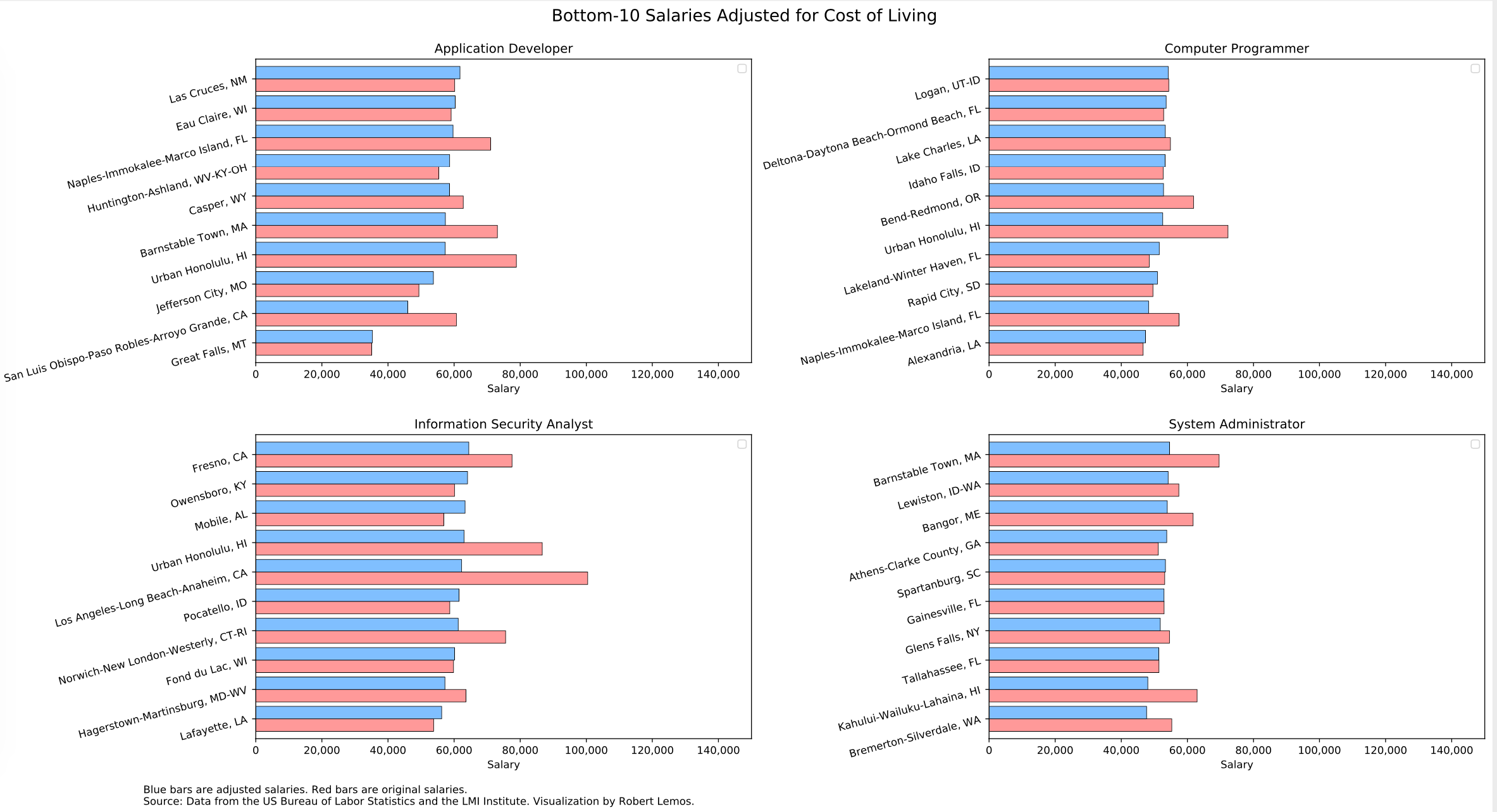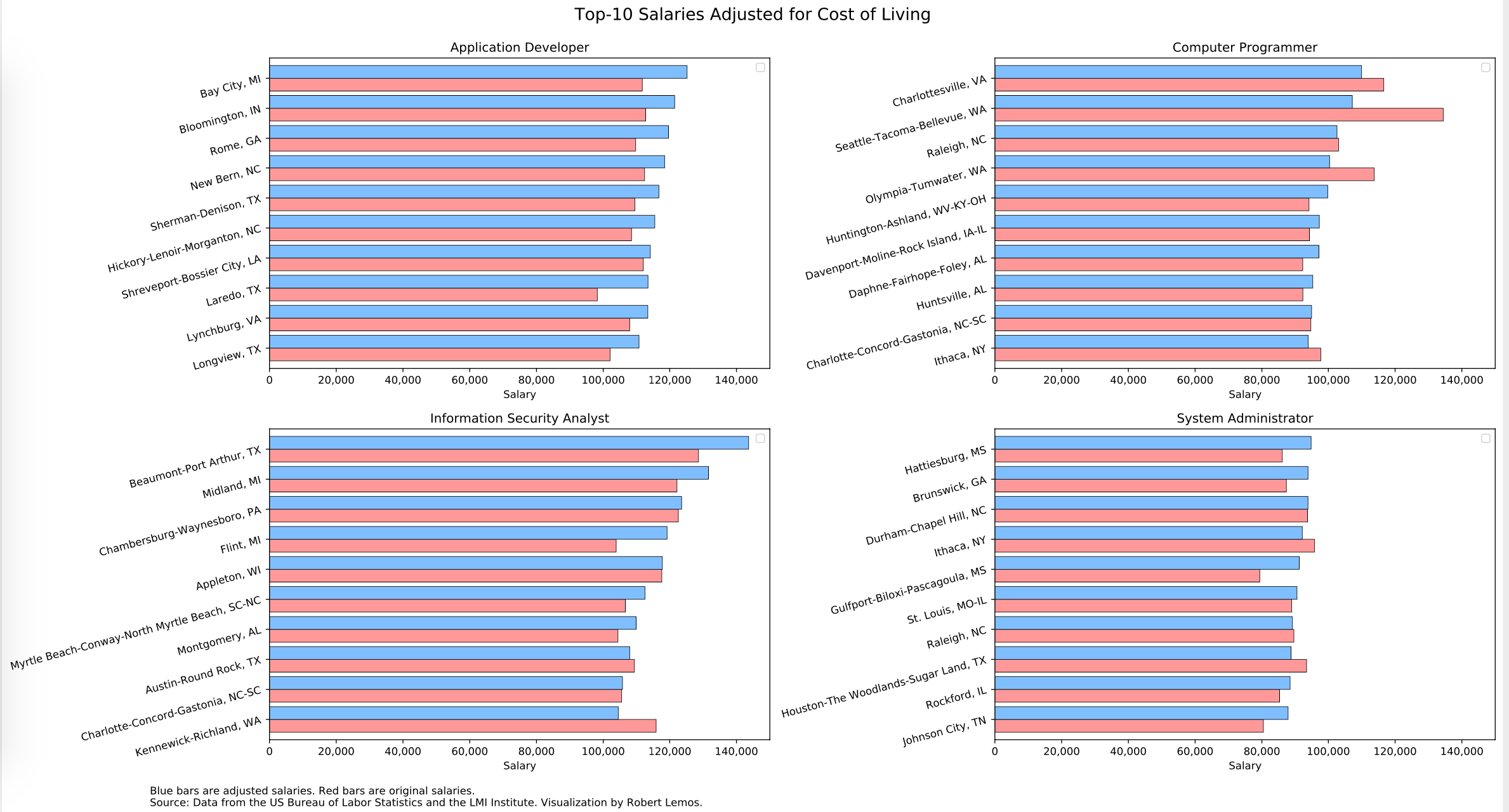DevOps skills are in demand, but your compensation can vary widely depending on where you work. The average application developer earns $138,000 in the San Francisco Bay Area. Information security analysts can score $123,400 in the New York City region. And systems and network administrators command an average of $107,600 in San Jose, California.
There's just one catch: These salaries are all in metropolitan areas where living costs are high. When you take into account cost-of-living expenses, the San Francisco-based application developer's salary declines to an effective wage of $86,000, while the New York City-based information security analyst's effective salary declines to $80,400, according to data from the US Bureau of Labor Statistics and cost-of-living data from the LMI Institute.
At the top of the list of locations delivering high adjusted salaries for application developers? Bay City, Michigan; Bloomington, Indiana; and Rome, Georgia. These small and mid-sized cities are becoming the new technology hubs as demand continues to grow for tech-savvy workers.
And companies looking for tech talent are increasingly likely to employ people in smaller metropolitan areas, whether as remote workers or by opening up offices in these nascent tech hubs, said Jim Johnson, senior vice president at Robert Half International, a global human resources consulting firm.
Cost of living "in New York is 40% above the national average, Chicago is 24%, and even Minneapolis is 7%, but Duluth is 20% below—companies are going to look at where they can be most cost-efficient," Johnson said.
The worldwide coronavirus pandemic has already caused chaos among workers and employers, and thus any analysis needs to be taken with a grain of salt, but the concentration of software development, application security, and operations jobs—including both traditional and DevOps roles—in major tech hubs will likely not change. Yet the pace of hiring and acceptance of remote workers will also increase, as will the transition of other, smaller metropolitan regions into tech hubs.
Here are five lessons from a TechBeacon analysis of salaries for four occupations, and other analyses of tech salaries and the cost of living around the United States.
1. Cost of living makes a difference, but is not the only metric
California dominates the list of top salaries for developer, security, and operations jobs. Eight of the top 10 average salaries for application developers are in California, along with three of the top 10 information security analyst salaries, four of the top 10 programmer salaries, and two of the top 10 system administrator positions.
Yet, once adjusted for the high cost of living in the state, no California job \ makes the top 20 lists of adjusted salaries for jobs in development, operations, or security. In one of the more conspicuous examples, a six-figure average salary for information security analysts in the Los Angeles area amounts to just $62,300 when you factor in the cost of living.
Figure 1. The bottom 10 salaries by metro area, adjusted for cost of living. Click on image to enlarge.
While Seattle-area programmers had the second-highest adjusted salary, even after a significant decrease due to cost of living, an analysis of the adjusted salaries for four professions—application developer, computer programmer, information security analyst, and system administrator—found that no other area broke the top 20 lists. In its own analysis, Indeed.com found that smaller cities typically had higher adjusted salaries, but for many technology jobs, that was not necessarily true.
Figure 2. The top 10 salaries by metro area, adjusted for cost of living. Click on image to enlarge.
Jed Kolko, chief economist at the job site Indeed.com, wrote that location was not a binary choice.
"When it comes to what many job seekers care about most, smaller cities often are best, [but] as always, the right city is ultimately a personal choice—it depends on what job you’re in and whether you value a higher adjusted salary above all else."
—Jed Kolko
Application developers in Laredo, Texas, and Yuma, Arizona, see the largest gains from cost of living, while information security analysts in the Beaumont-Port Arthur area of Texas also see a significant increase due to low cost-of-living expenses.
Nonetheless, the established technology hubs still hold allure for companies and continue to snag the lion's share of job postings, according to Indeed.com. Silicon Valley—the San Jose, Sunnyvale, and Santa Clara area of California—grabbed 23% of all job postings on the site in 2018. The government-heavy greater Washington, DC, metropolitan area accounted for 15%, while Seattle snagged 13% and the San Francisco Bay Area accounted for 12%.
2. Working remotely can deliver big salaries and low cost of living
Remote working has allowed some workers to essentially do salary arbitrage, getting paid high salaries while working in less expensive areas of the United States, or the world. As the coronavirus pandemic rewrites the rules of remote working for most companies, worker location may become far less important, allowing more developers and security and operations professionals to work from home.
"Companies are willing to look wherever they need to look to find the right skills, Even before coronavirus, companies were offering people remote work opportunities as long as they had the skills."
—Jim Johnson
That's the case at application security firm Veracode. With about two-thirds of the Burlington, Massachusetts-based company's application security research team working from remote locations, chief research officer Chris Eng said that skills matter, not location.
"Larger geographies, such as Asian versus North America versus Europe, may have different salary levels, but my point of view is this: If the job has a certain market value, and I would pay that for a person living in Boston, I don't see the need to penalize them for living somewhere else."
—Chris Eng
While this situation works best for US workers who want to be paid equally for equal work, companies—especially those that have a significant remote workforce—are starting to take into account cost of living when setting compensation. GitLab, an entirely virtual provider of developer services and software, has an online compensation calculator that accounts for where an employee lives. With the San Francisco market as the base to calculate the cost of living, the company may only offer 63% of that base to workers living in the least expensive parts of the United States.
Johnathan Hunt, vice president of security for GitLab, said salaries were adjusted.
"When they move to a lower-cost area, their salary is reviewed, but their benefits don't change, which is a significant incentive."
—Johnathan Hunt
3. Small and mid-sized cities deliver best salaries, lower costs of living
For the most part, the locations that are a "deal" for workers are those with demand for technology workers but a constrained market and low cost of living. Essentially, these are small and medium-sized cities, including many of the up-and-coming tech hubs, such as Research Triangle in North Carolina, which includes the cities of Durham and Chapel Hill.
As a tech hub on the rise, Huntsville, Alabama has the highest share of technology postings—18%—in cities of 500,000 to 1 million people, according to Indeed.com. In addition, job postings for Huntsville get 43% fewer clicks than the average for the United States as a whole.
When thinking about places to live, workers should consider that companies may pay local rates, and then come to their own conclusions about the loss of income, the difference in the cost of living, and intangibles such as an urban or a rural lifestyle.
Brittany Rohde, the compensation and benefits manager at GitLab, has moved four times, and each time the company has recalculated her salary. Her most recent move was to a more expensive area, and she acknowledged that the inevitable conversation—to raise her pay—was easier for her. Team members and the community know what our pay ranges are, 1) because we post them transparently in our compensation calculator, and 2) we explain why we pay local rates, Rohde said.
"So, while there may be some pushback, we are transparent and open to change, and in the end, the [worker] knows what to expect."
—Brittany Rohde
4. Tech skills continue to be in demand
While demand has spiked for specific disciplines—such as specialists in artificial intelligence and blockchain—developers and operations continue to be major growth areas for employment, according to Robert Half International. Cloud specialists, data specialists, web developers, DevOps engineers, full-stack developers, and security specialists are all widely sought after, the firm said.
"With technology jobs, in general, you can make the statement that there are more openings than there are people. Companies are willing to look wherever they need to look to find the right skills."
—Jim Johnson
Indeed.com has also seen a growing market for certain technology skills. SQL, Java, and Python are the programming languages most often mentioned in job postings, according to the site, with Python listings growing by 123% in the past five years, surpassing both C and JavaScript. The knowledge skills with the highest growth are all abilities needed for cloud work, including AWS, with 418% growth over five years; Azure, with 1,107% growth; and Docker, with 4,162% growth.
"Of course, software engineers and full-stack developers, to name two common tech job titles, increasingly use Python," Andrew Flowers, a former economist for Indeed.com, wrote in a post last fall. "And those same workers use AWS a lot too. But a big reason behind the exceptional growth of Python and AWS is that the underlying tech job mix is changing in ways that favor these programming languages."
5. The coronavirus pandemic could change everything
Much of this data is from 2018 and 2019, and technology changes quickly. However, the coronavirus pandemic has created chaos in the markets, dramatically sped up the trend of remote working among technology workers, and will likely lead to a massive drop in economic output, with some estimates suggesting a 30% unemployment rate and a 50% drop in GDP in the second quarter.
So far, job postings are just slightly down in 2020, declining 2.6% as of March 14, compared to the previous year, according to Indeed.com. Much of the decline is due to a lack of typical growth in the hospitality, tourism, and aviation industries, which is slightly offset by a rise in demand for supply-chain jobs, such as loading and stocking positions.
"The global economy is coming under considerable strain from coronavirus and containment efforts, including social distancing. The slowdown in the US labor market is showing up in the data for job postings on Indeed."
—Jed Kolko
Expect more tech jobs to go to remote work
A contraction in the overall US economy could, of course, lead to a contraction in the technology workforce. However, software development, application security, and operations professionals continue to be in demand.
Moreover, the increased reliance on cloud-based workloads and remotely managed infrastructure will likely lead to greater demand for workers who have the skills to deal with those technologies. These jobs usually can transition to remote work and more will probably do so—even after the pandemic is over.
Keep learning
Choose the right ESM tool for your needs. Get up to speed with the our Buyer's Guide to Enterprise Service Management Tools
What will the next generation of enterprise service management tools look like? TechBeacon's Guide to Optimizing Enterprise Service Management offers the insights.
Discover more about IT Operations Monitoring with TechBeacon's Guide.
What's the best way to get your robotic process automation project off the ground? Find out how to choose the right tools—and the right project.
Ready to advance up the IT career ladder? TechBeacon's Careers Topic Center provides expert advice you need to prepare for your next move.





